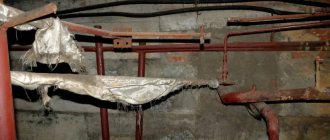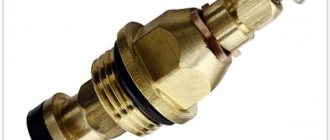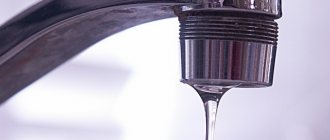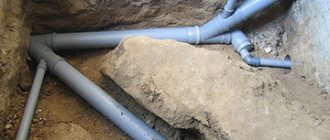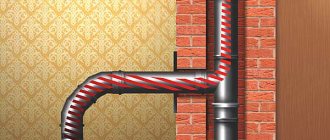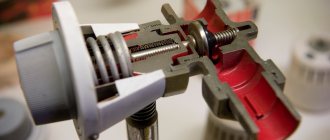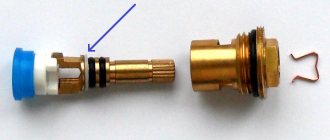Before finding out the cause of noise from a valve or mixer, let's try to understand its nature. Any sound is acoustic vibrations of a certain frequency generated by vibration. For this reason alone, such a phenomenon requires special attention, because it is possible to enter the resonance phase and then you need to expect trouble, since in this case the amplitude of the oscillations increases sharply.
This is usually followed by the destruction of resonating objects. Therefore, finding out in a timely manner why the faucet makes noise when you turn on the water means avoiding major troubles associated with possible major repairs.
Possible causes of faucet humming
Noise in the tap appears as a result of water passing through the cartridge installed inside the mixer.
In this case, a sharp drop in pressure occurs, which causes sharp sounds. The noise that appears every time you use the faucet is very annoying and can cause headaches for some people. To solve the problem, you must first understand the type of faucet and determine which faucet makes noise when you turn it on - hot water or cold. Mixers can be conventional valve and lever. For faucets of the first type, the flow, volume, and temperature of water are regulated by a valve mixer by turning the faucet-axle, which is located under the decorative handle. The axle box can be traditional with a rubber gasket or ceramic. An ordinary crane axle box may hum due to a worn-out rubber gasket.
The cause of noise in a ceramic faucet is the silicone liner. It is impossible to replace it; the entire crane must be dismantled. A lever mixer does not have valves. The water supply can be regulated by the ball valve included in this device or by a valve with a ceramic cartridge. If they make noise when turned on, in this case you just need to adjust the pressure in the supply pipe. Lever mixers are more reliable.
Types of faucets
Before you start repairing the device, you first need to find out what type of mixer tap you will be dealing with. This is due to the fact that each type has its own characteristics, which can become a source of problems if the approach to repair is incorrect.
Based on the type of pipe routing that supplies water, mixers are divided into vertical and horizontal. There are also subspecies, such as:
- two-valve;
- thermostatic;
- single lever;
- contactless.
Each of them has its own characteristics, knowledge of which will greatly simplify the work when troubleshooting future problems or breakdowns.
Circumstances of origin of noise
Most often, noise appears in locking mechanisms and faucets due to the phenomenon of hydrodynamic cavitation.
Cavitation is a process that occurs when the pressure decreases and the subsequent appearance of bubbles or cavitation cavities (cavities) in the liquid, which then collapse when the pressure equalizes with energy release in the form of shock sound and waves.
If the valve is working properly, then when it opens, the transient process with a large pressure drop in the liquid flow continues for a very short time, and virtually no noise appears.
But due to the wear of the sealing gaskets, a local drop effect can be observed, where cavitation cavities with a characteristic hum or whistle will form.
In addition, the noise may be caused by a poorly secured external pipe at the point of its narrowing, which, during the passage of the water flow, enters into resonance and begins to vibrate, emitting low-frequency sounds.
In this case, it is enough to fix the pipe in a stationary position using additional brackets or gaskets. Quite often, such a problem occurs in flexible hoses that are connected to the mixer.
If you hear a noise in the bathroom when turning on the water, you need to take a couple of actions:
- Find out which faucet is making the noise . To do this, open the warm and cold water valves one by one, and in this way identify the source of the sound;
- Find out the type of crane axle box (head) . This is easy to do: if you need to make two or more turns of the valve to open, it means you have a faucet with a rubber gasket. If it takes no more than a turn to open, your faucet is equipped with a ceramic head;
- If the noise appears somewhere under the sink, it means the flexible hose is making noise . It will need to be tightened and secured using any ergonomic method.
Note! Much more often, the noise is caused by the worm-mounted valve axle due to wear of the rubber gasket. But the ceramic head can also make noise, since the silicone ring can sag and the axlebox becomes less dense.
When it leaks from under the nut
Very often, leakage occurs due to a loose nut. Therefore, first you should try to tighten the nut more tightly. If this doesn't fix the problem, it's most likely a gasket issue.
If water continues to leak, you should first dismantle and disassemble the product. Most often, the problem is a rupture in the seal. The key needs to be replaced.
To work you will need an adjustable wrench.
- Unscrew the nut.
- Remove the old key from the gander.
- Replace the old gasket with a new product.
- Wrap two layers of tape around the thread.
- Insert the gooseneck into place and tighten the nut.
Scientific explanation for the appearance of hum
The appearance of sound waves from vibration is the answer to the question why the faucet whistles when you turn on the water. The question arises about the reasons for the appearance of vibration waves. There are several of them:
- increased pressure in the water supply. Then the unpleasant sounds will spread throughout the entire riser in the multi-story building. The consequences can be costly due to pipe breaks and forced pipe replacements. It will be especially difficult if the breakdown occurs in a hard-to-reach place;
- there may be a blockage in the metal pipes. Rust and small debris have accumulated as a result of long-term operation of the pipeline. All this will affect the appearance of vibration waves and the whistling of the mixer;
- incorrect installation of metal pipes provokes the appearance of a “melodic” song;
- an error when installing the gasket in the tap or its defect.
Causes of whistling water pipes
Characteristics such as frequency of occurrence, tonality, nature and presence of vibrations give an idea of what causes noise in the water supply. Let's look at why the faucet hums when you turn on the water, guided by knowledge of physics. The main reason is sound waves due to vibration, which appears due to:
- Quite a strong pressure in the pipeline - in this case, the sound will be heard when you open the mixer, not only in the entire entrance, but throughout the house. This may indicate possible damage to the pipeline in a hard-to-reach place. As a result, there is a possibility of expensive repairs for both you and your neighbors.
- Wear of the metal pipeline - a hum is heard when the tap is turned off due to the fact that lime and other deposits accumulate on the walls of the pipes, and also rust. This can also cause vibration and hum in the pipes when the water is turned on.
- Incorrect connection of pipes during installation is a fairly common cause of an unpleasant hum. Therefore, if the water tap starts to hum when turned on, you need to check all connections between the pipes and elements of the system.
- Wear of the gasket is the most obvious malfunction; because of it, the water supply tap not only makes whistling and humming sounds, but in addition also leaks.
- Incorrect installation of the valve results in an unpleasant knocking sound in the pipes. Due to incorrect installation of the screw valve, the valve comes off quite often. The valve hits the inner walls of the pipe, and as a result, blocks the flow of water.
Helpful advice! A hum in pipes is a fairly common phenomenon in private systems or new homes. These sounds from the water supply most often indicate poor-quality repairs, after which the pipes are located very close to each other. This sound comes from the contact of vibrating pipes. To solve this problem, each pipe must be wrapped in foam insulation.
Structural features of cranes
Taste preferences and financial capabilities are two main factors influencing the choice of a mixer tap. Any type of product can be repaired, which can sometimes be carried out even by the owner himself. Let's take a closer look at the design features of these devices:
- Two-valve. Their obvious difference is the presence of two valves, which are adjusted separately. The crane axle box is the basis of such a product. Their weak point is the gaskets, which need to be changed quite often.
- Thermostatic. Their main advantage is the ability to pre-set the thermal regime of the supplied water. Such devices are not very popular due to their high cost.
- Single lever is the most popular type. Adjustment can be made by turning the tap to the side, or up and down. The basis of such a device is a ball mechanism. They gained popularity due to their simplicity, convenience and cost-effectiveness.
- Contactless. Built-in infrared sensors regulate the water supply - it is carried out at the moment when you bring your hands to the device.
Why is the faucet humming? There may be several reasons. Here are the main ones:
- Pipe wear. Why is the water tap humming? The fact is that any appliance has a service life, and if the house has not undergone major repairs for a long time, it is quite natural that the pipes began to hum due to old age.
- Poor quality repairs. Why is the hot water tap humming? If the technician connected the pipes incorrectly or poorly insulated them, they may hum and rattle.
- High pressure in pipes. Why does the faucet hum when you turn on the water? Why is the cold water faucet humming? There is only one answer - due to high pressure in the water pipes. This reason is far from uncommon, so before moving on to direct plumbing repairs, it is recommended to check the pressure level.
- Failure of the faucet shut-off valves is the most common cause of faucet rattling. Sometimes the rattling turns into a characteristic growl. The cause of the growling is faulty fittings. Also, if the hum of the mixer is observed only in your apartment, and not in the entire residential building, the problem is probably in the fittings. After replacing it, the noise most often disappears.
Let's look at each type of repair separately.
Lever mixer and the reasons for its noise
Lever mixers are characterized by increased wear resistance. They are intended for areas with high pressure and the presence of salts in the liquid. Even with significant wear of the structural components, it continues to work. In view of these characteristics, the reasons why the crane is humming are unlikely to lie in its design. The likely cause of the hum is unusual water pressure in the pipeline.
Lever mixer
A solution to this problem can be the installation of a special gearbox in the area between the product and the pipe. With its help you can equalize the pressure in the system. The gearbox allows you to avoid buying a new mixer. The permissible pressure for efficient and silent operation of the crane is 2.5 atmospheres. A higher rate can lead to excessive wear of the rubbing elements of the product.
If the faucet begins to make noise not immediately after installation, but after some time of operation, then the cause may be excessive salt deposits. They clog both the pipeline and small parts of the product, leading to friction, cracking, and loss of integrity of metal components . In this case, you need to either regularly replace the faucet or install cleaning structures - filters.
The main reasons for the noise of valve mixers
To find out why a valve-type faucet is humming, you first need to figure out which faucet the hum is coming from. After this, you need to perform several smooth turns of the tap to understand what type of gasket is in it: rubber or ceramic. To open a faucet with a rubber gasket, you need to perform two or more turns, with a ceramic one - one turn.
A rubber axle box can be repaired, while a ceramic one can only be replaced. It's all about the silicone gasket, the wear of which causes the ceramic rings of the system to lose their correct position. Reduced functionality of the gasket makes it impossible for the faucet to hold pressure, which is why the faucet whistles.
Crane axle device for rotary mixer
The correct choice of a new product depends on the optimal selection of its diameter. There are no standards that regulate the size of a silicone liner, so each manufacturer produces it at its own discretion. To choose the right product, you need to disassemble the faucet and take the insert with you to the store.
Ways to solve the problem
Having determined why the faucet is whistling in the bathroom, you can begin to solve this annoying problem. Troubleshooting methods depend on what caused the breakdown. To eliminate humming in pipes, the following solutions are used:
- If the pipes in the house are humming due to too much pressure, then only the management company can solve the problem and eliminate the noise; the residents of the house will not be able to cope with it. Therefore, in this case, it is best to send a written request to the service organization and call a technical specialist.
- If the noise occurs due to old age or dilapidation of the water supply system, then only complete replacement of pipes with modern metal-plastic ones will help. The management company should also do this.
- If humming occurs due to unqualified pipeline repairs, you should also contact the management company. They must figure out where the pipes are in contact with each other, causing vibration and chatter, and then correct the installation defect.
- When a faucet is noisy due to a broken shut-off valve, the problem must be addressed by the homeowner himself. To do this, most often it is enough to replace or clean the beaker in the mixer, which can be done with your own hands.
replacement of crane boxes
Important! The faucet in the mixer is activated by turning the knob; it is needed to close and open the flow of water. Due to the fact that tap water contains many different impurities, and plumbing equipment is often of poor quality, bottles often become clogged or fail; in fact, they are consumables that require replacement every 1-1.5 years.
What is the mixer singing about?
When the faucet is humming in the bathroom...
Almost every person has encountered such a problem when the faucet is noisy, and it does not matter whether the faucet is installed new or old. There is an opinion that this malfunction cannot be eliminated and the faucet must be replaced. So, let's see if this statement is really true.
Help: No matter how scary a breakdown may seem, in reality everything is quite simple. When the water supply is opened, the process of cavitation occurs - low-frequency vibration generated by a sharp drop in pressure of the liquid passing inside the mixer. For this reason, the faucet in the bathroom or kitchen usually hums.
But how to fight it? After all, this noise has an adverse effect on the nerves, and when there are small children in the house, the constant noise heard when opening the tap becomes a serious problem. But before you start troubleshooting, you need to find out what kind of crane design you had to deal with.
Having figured out the question of why the faucet is noisy in the bathroom or kitchen, you need to understand which part of the faucet is to blame for the unpleasant sounds. To do this, hot and cold water are opened alternately. The tap that caused the hum to open will have to be repaired.
Diagnosis of the problem
Many homeowners have encountered the problem of a humming faucet. Moreover, this fate will not escape either the owners of old “Khrushchev” buildings or the happy owners of brand new apartments with an improved layout. At first, the noise, hum and whistle inside the pipes only brings inconvenience, as it irritates the residents or wakes up sleeping household members at the wrong time.
Over time, homeowners become so accustomed to the constant sound effects that they stop noticing them. However, such a “musical” water supply can subsequently cause a serious accident, so noise from the pipes must be dealt with.
In the first stages, it is important to understand where the noise is coming from in order to understand how to solve this problem. To identify the cause of the hum, you need to alternately turn on cold and hot water in the sink or bathtub; it is more convenient to do this when there is complete silence at home.
To determine the malfunction, you need to find out not only the location of the hum, but also determine the moment when it appears: when opening and closing the tap or at the moment when water is simply flowing. Also, when diagnosing a problem, it is useful to determine whether there is vibration in the pipes and its intensity.
Note! Sometimes the noise from the tap is so loud that it can be heard even from the entrance. And sometimes, on the contrary, it is so weak that it is barely noticeable only when it is absolutely quiet. As a rule, this phenomenon, regardless of the volume, indicates a malfunction of the plumbing system, so it must be dealt with.
When the shower hose leaks
Shower hose malfunctions
Another common reason for a leaking bathroom faucet is a leaking shower head hose. The cause of water breakthrough may be worn gaskets under the hose nuts or wear of the hose itself.
To fix the problem, you will need to make or purchase rubber or paronite gaskets half an inch in size. Also for repairs you will need FUM tape, rags, pliers and a screwdriver.
To troubleshoot a hose that is dripping, you do not need to disassemble the faucet in the bathroom, but the following steps are sufficient:
- First of all, unscrew the hose at the leak site (on the watering can or faucet) using pliers with a piece of rag placed under it. This is done to prevent scratches on the hose;
- Next, we inspect the damage and replace the gasket with a new one;
Important! Sometimes the reason when a bathroom faucet leaks is not the gasket, but the hose itself. There is a rubber tube inside the metal sleeve, which can break at the junction. To repair it, simply pull out the clamp cone, replace the tube and reinstall the clamp.
- At the next stage, the threaded connection is cleaned of the old seal and a new FUM tape is wound;
- And finally, we reassemble and check that the faucet in the bathroom is not dripping. It may be necessary to re-tighten, but the main thing is not to overdo it because you can crush the gasket, and the procedure will have to be repeated.
Having dealt with the question of why the faucet in the bathroom is leaking, you need to decide on the feasibility of repairs. After all, it often happens that the necessary spare parts are not available in stores, due to the model being outdated and discontinued. If gaskets need replacing, but they are not available in stores or are not produced, you can always make them yourself. To do this, a gasket is cut out of a piece of rubber or paronite of the required thickness using scissors. Or perhaps it would be easier to replace the faucet with a more modern one.
If a single-lever type of faucet is humming
A single-lever mixer is usually one of the most reliable plumbing products. However, even this begins to fail over time.
Why is the bathroom faucet humming? The reason for the hum of a single-lever device is the wear of the plates located in the cartridge of such a faucet. In this case, the tap makes noise precisely when opening and closing the water. Another reason may be wear of the gasket (key).
Typically, cartridges are not repaired. Instead of an old cartridge, you simply buy a new one. Replacing the cartridge is very easy - you can easily do it yourself. You need:
- Unscrew the handle of the product.
- Remove the damaged cartridge.
- Replace the cartridge with a new one.
- Screw everything into place.
By following these simple steps, you can easily replace a failed key yourself.
Noise in pipes when the tap is open
When water begins to flow from the water supply, in addition to the appearance of a loud hum, vibration usually occurs in the system. Sometimes the reason why the pipes hum when you open the tap is the faucet on the mixer. When an abundant water flow appears, it begins to vibrate.
In this case, the water pressure increases, the valve block blocks the pressure, and then turbulence is formed. Therefore, if the pipes hum when the tap is opened, the main thing that needs to be done is to check the functionality of the tap - the axle box. It will not be difficult to find out which faucet is causing the problem. You should open them one by one, first, for example, with cold water, and then with hot water.
According to experts, crane axle boxes with rubber gaskets often cause a lot of trouble, not counting unpleasant sounds, so it is advisable to abandon them. Craftsmen recommend installing ceramic faucet axle boxes from foreign manufacturers - they are characterized by compatibility with domestic mixers.
Such products operate silently, do not leak over time, and do not require gasket replacement. But, if unpleasant sounds occur when using a ceramic axle-box tap, then the product was installed incorrectly.
In the case when new plumbing has been installed in the apartment, but the pipes in the bathroom and toilet still vibrate and hum when you open the taps, you need to check how correctly the fastening of the pipes and faucets is done. Usually, extraneous sounds disappear after sealing the joints of system elements.
If there are noises in the plumbing structure that suddenly appear and soon disappear, their possible cause is the presence of faults in the neighbors’ apartments.
Another explanation for the appearance of a hum in the pipes when the tap is open may be the excess pressure present in the pressure system. This problem most often occurs at certain times of the day when the pressure in the water supply reaches its highest value.
Too much load on the system is undesirable, not only because the pipes in the riser are humming. A sudden impact on the pipeline can disrupt the operation of the entire water supply structure and cause depressurization of the junctions of its sections.
You can try to reduce too high pressure by placing an air chamber in the free space between the pipes and the tap. To create such a chamber, either an additional piece of pipe or a muffler specifically designed for pipes is used.
If the toilet tank is noisy
The toilet cistern may also make a loud noise when it is filling. As professionals say, this problem can be solved quite easily on your own. Most often, the cause of the noise lies in the intake mechanism.
Usually, when a drain fitting is assembled, a tube is installed on the inlet valve, one end descending almost to the bottom of the tank. As soon as the water closes the tube when filling, the noise disappears.
The reasons in this case are not important - whether the tube fell off on its own or whether it was simply not installed during assembly. The main thing now is to eliminate the noise of water when filling the tank.
If the cutting has fallen off, just put it back in place. If it is lost, you need to select a suitable piece of plastic or rubber tube and install it in the drain tank.
So, why are the water pipes or faucets humming in the apartment? “Music” when opening a tap in the kitchen or bathroom is a sign that there are some problems in the plumbing system of the apartment or house that require immediate correction. There is no need to wait until the situation reaches a critical moment when emergency measures are required. You just need to use our tips to help solve this problem on your own.
How to repair a noisy faucet?
Let's look at one of the main reasons for the hum in the mixer, namely an incorrectly installed, defective or worn-out tap-box gasket. It is because of this that most often the faucet begins to “sing” and at the same time leak.
Let's look at this problem in more detail:
- It is necessary to determine when you open which tap the “music” of cold or hot is heard.
- Shut off the appropriate supply yourself.
- Dismantle the crane axle box on which the gaskets we need are located. A faucet is a device that regulates the water supply. As a rule, it is located under the valve.
- Worn gaskets need to be replaced; they are not very expensive, so it is better to choose the best ones. Rubber or ceramic products can be used. In order to determine this without disassembling the tap, you need to open it. If it is necessary to make only one turn to open, then a ceramic gasket is installed; if more, a rubber gasket is installed.
Repair of a tap with a rubber gasket:
- Remove the crane axle box.
- Using a sharp knife, cut the edge of the gasket at a 45° angle. But you need to remember that the cut should not be more than 1mm.
- If the gasket is completely worn out, it is better to replace it immediately.
- After all installation operations have been completed, it is necessary to reassemble the valve.
- Open the faucet and test for leaks and humming noises.
Advice: the most likely cause of leakage and “singing” of a faucet with a ceramic faucet axle is a sagging silicone washer, which is necessary for pressing the ceramic parts together.
It is recommended to cover the silicone ring with plastic after disassembling the valve axle. As a rule, after this the problem of leaks and unpleasant sounds disappears.
The measures suggested above are temporary. Therefore, it is necessary to go to the store as quickly as possible and replace the failed crane axle box.
Replacing the gasket to fix the problem
Wear of the crane axle box gasket or its defect is considered the main reason why the crane growls. A damaged gasket also means an additional leak in the mixer.
At the first stage, it is necessary to determine where the unpleasant sound is coming from: hot or cold water supply. It is easy to guess that the taps open and close alternately. For example, a burning water faucet whistles. The liquid supply to this mixer is shut off. After this, the crane box is dismantled. There are gaskets on it that require replacement with new ones. The fluid supply is adjusted using the axle-box valve. You need to look under the fluid supply valve.
The faucet in the bathroom is noisy, what should you do if the reason is the ceramic faucet? There is an opinion that only rubber gaskets cause problems. In practice, it turned out that ceramic axle box gaskets will not be a complete solution to the noise in the mixer. Their improper installation or wear over time will lead to the question of why the faucet in the bathroom is whistling.
There is an easy way to find out what material the gasket is made of. In this case, there will be no need to unscrew the mixer design. With a rubber gasket, the valve is turned several times to open or close the water supply. With a ceramic gasket, it is enough to turn the valve once and water will appear in the mixer.
So, why does the faucet hum in the bathroom when you turn on the water, what should you do to replace the rubber gasket of the faucet axle box:
- The crane axle box is pulled out from its place. The rubber gasket along the edge is cut at an angle of 45 degrees. The cut is made 1 mm deep.
- If the wear of the gasket is too great, then a new gasket is purchased for replacement.
- As soon as the new part is installed, it will be necessary to check the quality of work so that there is no leakage and continuation of the hum.
The rubber gasket can only be reused in its elastic state. If it has become oak, then it is necessary to replace the gasket.
Reassembling the mixer is carried out in the reverse order. When assembling, it is important to wrap FUM tape around the threads at the joints for better sealing.
As mentioned above, an unpleasant sound is also produced with a ceramic axle-box valve. The silicone washer subsides, which forces the parts of the valve axle to press against each other. When these ceramic parts come together, the faucet begins to leak and hum. Work in progress:
- The crane box must be disassembled.
- The silicone ring is covered with plastic.
- The work will be completed.
You need to be aware that repairing a crane axlebox gives results for a short time. It is recommended to call a plumber to fix the leak and whistle. But if the decision is made to fix the problems, then it is better to immediately install new models of axle-box cranes. Otherwise, you will face repeated repairs.
Gasket repair
When replacing gaskets, consider the following:
- The type of rubber for gaskets should be taken into account the standards of GOST 7338-80. The most durable gaskets are made from soft sheet rubber of the TMKSh brands of classes 1 or 2. The material is operational at temperatures up to 800C and pressures up to 10 MPa.
- When purchasing ready-made gaskets in a store, do not hesitate to ask the seller about the material of the product: in small retail outlets you may come across gaskets made from non-molded rubber.
- Rubber-fabric plates as blanks for making gaskets are not suitable: the coefficients of thermal expansion are different, and the hydrophobicity (swelling) of the gasket is increased when left in a humid environment for a long time.
At the same time, inlet valves on pipelines should be replaced with ball versions: they close the water flow faster in case of an emergency. Beware of Chinese-made products: the actuators - the one-armed lever and the ball in such products are often made of steel of unknown quality.
Cartridge repair: features
Shut off the cold and hot water supply in the bathroom or kitchen. Using a screwdriver, pry and pull out the button showing which side the hot and cold water is on. Unscrew the screw that holds the lever using a hexagon and remove it. Then you remove or unscrew the cover, it depends on the model. Use an adjustable wrench to unscrew the clamping nut and pull out the cartridge. Buy exactly the same one and reassemble it in reverse order.
For any kitchen or bathroom faucet repair work, you may need the following tools:
You can do all the work yourself or call a plumber; in both cases it will not take much time, effort or money. Humming, whistling or noise coming from the faucet is not only an irritating factor, but also a sign that the plumbing is in disrepair and repairs should not be put off for a long time.
Crane axle box with rubber
A product with a rubber lining very often develops a characteristic whistle. Why does the faucet whistle? It's all about the cartridge again.
If you have a crane axle box installed with a rubber gasket, replacement is carried out as follows:
- It is necessary to remove the cover from the valve handle
- The faucet axle box is unscrewed from the mixer body.
- Using tools, you need to unscrew the washer responsible for fixing the gasket.
- A new key is installed, all unscrewed parts are returned back.
Such simple manipulations help eliminate the humming sound in the tap.
Crane axle box with ceramics
The first steps of replacing faucet axle boxes with ceramics are similar to those carried out with faucet axle boxes with rubber - you need to unscrew the ceramics from the mixer. After removing it you must:
- Pry off the cartridge with a thin screwdriver, as it is fixed in a special groove.
- After changing the gasket (cartridge), you need to make sure that you firmly fix the new gasket into this groove.
With these simple manipulations, you will effectively eliminate noise in your mixer tap.
When the mixer valve leaks
The most common causes of leakage from under the valve are wear of the seal rings or breakage of the valve axle box. To carry out the repair you will need: new sealing rings, a screwdriver, an adjustable wrench, and a new valve axle.
- — Remove the plug from the valve and unscrew the fastening screw.
- — We remove the valve, dismantle the crane axle box.
- — If the entire crane box has become unusable, replace it completely. If the problem is simply thinning of the rings, replace only them.
- — Put the valve back on.
Now our valve is like new! Nothing else is leaking.
Freezing pipes and other factors
The randomness factor cannot be foreseen or prevented. Even if all residents follow the rules for operating the system, problems still occur. The list opens with a bird that got into the ventilation shaft of the sewer system. As the volume of air entering the toilet decreases, a distinct gurgling sound is heard when flushing. Only an experienced plumber can remove the bird.
Before disassembling the pipe, place a container
The second common reason is frozen pipes.
Events develop as follows:
- An imbalance is created when the air temperature is low and the water temperature in the tubes is high;
- Frostbite on the internal surface of the system gradually increases;
- The plug forms within 4-5 days;
- It can only be removed while on the roof.
Even if you follow all the rules for operating the system, it is not always possible to avoid problems. If the results of the inspection indicate that it is possible to exclude a situational factor, for example, a traffic jam caused by neighbors, then you need to immediately check the factor of chance.
Rubber gasket
The first thing you need to start with is to remove the crane axle box. After this, you need to remove the gasket and trim it a little. This should be done carefully and should result in an angle of 45°. In this case, it is very important to control the cutting depth; it should not exceed 1 mm.
If the gasket is very worn, it is recommended to replace it.
After repair or replacement of an element, the crane is assembled. Finally, when opening the water, you need to check all places for leaks.
Ceramic gasket
Unlike rubber, ceramic gaskets are more reliable and durable. If a hum occurs in such a system, then most likely the cause of the malfunction is the silicone washers. It is with their help that the ceramic plates are pressed. To eliminate this problem, you need to cover the silicone parts with plastic.
But both options for repair work can only give a short-term effect. To eliminate the humming sound in the faucet, it is best to call a plumber, who will find the cause of such a defect and carry out all the required work to eliminate it. If the reason is in the crane itself, then it is worth replacing the crane axle box with a new one.
Water pressure
To check the pressure in the pipe, it is necessary to carry out a certain procedure. To do this, you need to open the tap completely and let the water flow a little. After this, the water should be turned off; if the hum does not stop, it means that the pressure in the water supply exceeds the norm. The following relationship can be derived: the higher the pressure in the pipes, the brighter and faster the hum will appear. In order to eliminate this problem, it is necessary to install a special air chamber in front of the tap. The main purpose of such an addition is to absorb sudden pressure changes in the pipe.
Diagram of the air chamber to the tap.
To install such a camera, you can use two methods:
- special auxiliary section of pipe of the required diameter;
- a muffler that will eliminate sound during the passage of water.
Such devices are manufactured in industrial conditions. They are equipped with a built-in chamber that will suppress significant surges in water pressure in the pipeline.
If vibrations of pipes and excessive humming of the screen occur in case of loose installation, additional compaction must be done using available means. You can do such work yourself, but if you are not confident in your own abilities, it is better to seek help from specialists. Once these seals and fixations of the pipeline are completed, the vibration and hum should stop.
